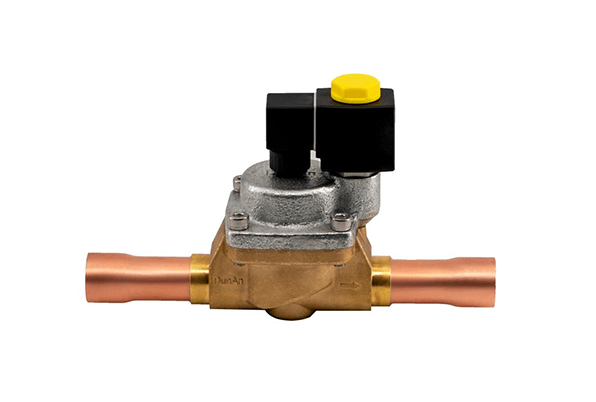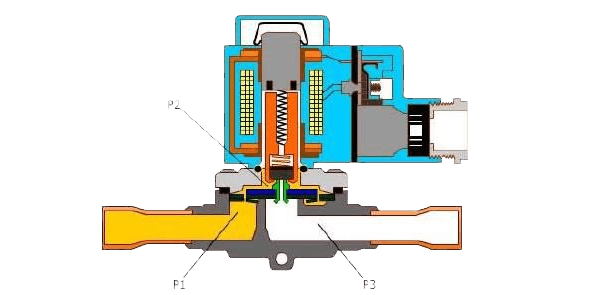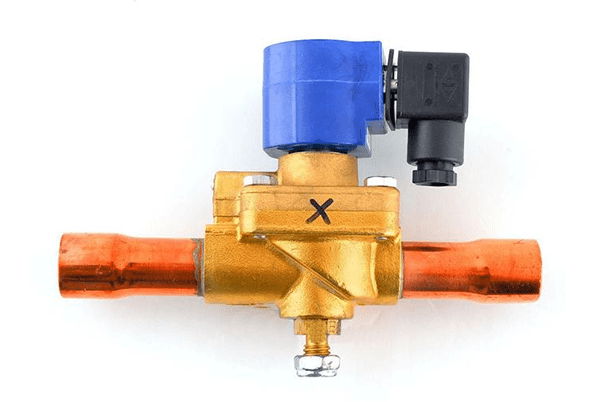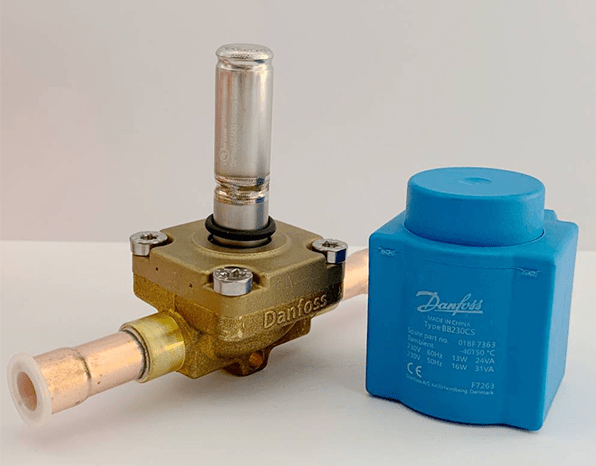
Every valve in the refrigeration system is very important. Their cooperation enables the system to operate normally. In the cold storage system, the refrigeration solenoid valve can not only control the flow of refrigerant, but also ensure the safe and stable operation of the refrigeration system. This article will introduce in detail the principle, function, selection and installation precautions of refrigeration solenoid valves in cold storage systems.
1. Working Principle of Solenoid Valve for Refrigeration
In a refrigeration system, the solenoid valve is placed in the refrigerant line. When the valve is open, refrigerant can flow through the line, allowing the system to operate. When the valve is closed, refrigerant flow is blocked, preventing the system from operating. This allows for precise control over the flow of refrigerant in the system.
Solenoid valves are typically controlled by an electronic control system, such as a thermostat or a microcontroller, which regulates the electric current flowing through the solenoid coil. This allows for precise control of the refrigerant flow in response to temperature or other system parameters.

P1=Pressure below the diaphragm (inlet)
P2 = Pressure above the diaphragm
P3=Pressure below the diaphragm (outlet)
2. Role of Refrigeration Solenoid Valve in Cold Storage
1. Controlling the flow of cooling medium
The solenoid valve can accurately control the flow rate of refrigerant to ensure that it is within an appropriate range, thereby preventing excessive or too small flow from adversely affecting the refrigeration system.
2. Adjusting the pressure of the cooling medium
By controlling the opening degree of the valve, the solenoid valve can adjust the pressure of the refrigerant to keep it within a constant range to avoid damage to the refrigeration system due to excessively high or low pressure.
3. Protecting refrigeration system
When an abnormality occurs in the refrigeration system, the solenoid valve can protect the refrigeration system and prevent damage to the unit.
4. Achieving automatic control
Solenoid valves can be used with electrical and electronic components to achieve automatic control. For example, by cooperating with a sensor, the valve can be automatically controlled based on the temperature signal to achieve precise control.

3. Selection of Solenoid Valves for Refrigeration
Selecting the right refrigeration solenoid valve involves considering several factors to ensure proper operation and compatibility with the refrigeration system. Here are some key considerations:
1. Refrigerant Type: The solenoid valve must be compatible with the specific refrigerant used in the system. Different refrigerants have varying chemical properties and operating pressures, so it's essential to choose a valve rated for the refrigerant being used.
2. Operating Pressure and Temperature: Consider the pressure and temperature range at which the solenoid valve will operate. Ensure that the valve is rated for the maximum and minimum pressure and temperature conditions expected in the refrigeration system.
3. Valve Size and Flow Rate: Select a solenoid valve with an appropriate size and flow rate to meet the requirements of the refrigeration system. The valve size should match the diameter of the refrigerant line, and the flow rate should be sufficient to handle the required refrigerant flow.
4. Voltage and Electrical Compatibility: Determine the voltage and electrical specifications required for the solenoid valve to operate. Ensure that the valve is compatible with the power supply available in the system and that the electrical connections match the control system.
5. Valve Configuration: Consider the specific application and system layout when choosing the valve configuration. Solenoid valves are available in various configurations, including normally closed (NC), normally open (NO), or bi-directional. Select the appropriate configuration based on how the valve will be used in the system.
6. Environmental Conditions: Evaluate the environmental conditions in which the solenoid valve will operate, such as exposure to moisture, chemicals, or extreme temperatures. Choose a valve with suitable construction materials and protection ratings (e.g., IP rating) to withstand the environmental conditions.
7. Quality and Reliability: Select a solenoid valve from a reputable manufacturer known for producing high-quality and reliable products. Consider factors such as warranty, serviceability, and availability of spare parts.

8. Compliance and Certification: Ensure that the solenoid valve complies with relevant industry standards and regulations, such as UL (Underwriters Laboratories), CSA (Canadian Standards Association), or CE (Conformité Européenne) certification, depending on the region and application requirements.
By carefully considering these factors, you can select the most suitable refrigeration solenoid valve for your application, ensuring reliable and efficient operation of the refrigeration system. It's often helpful to consult with a knowledgeable supplier or engineer to assist in the selection process.
4. Precautions for Refrigeration Solenoid Valve Installation
1. Installation Location
The solenoid valve can only work when the flow direction of the refrigerant in the solenoid valve is consistent with the direction pointed by the arrow on the solenoid valve. Normally, the solenoid valve is installed in front of the thermal expansion valve and must be close to it. This avoids a liquid hammer when the solenoid valve opens.

To install the coil, simply press it until you hear a click, which indicates that the coil has been installed correctly.
NOTE: Remember to install an O-ring between the valve body and coil. Make sure the O-ring is smooth, undamaged, and free of paint or any other material.

2. Pipe Connection
When connecting the solenoid valve to the pipeline, ensure that the connection is firm and well sealed to prevent refrigerant leakage. Also, make sure that the piping around the valve is properly installed to prevent rupture.
3. Electrical Connection
When connecting the electrical part of the solenoid valve, ensure that the power supply is stable and the grounding is reliable to avoid failure of the solenoid valve due to electrical problems.
4. Test and Inspection
After completing the installation, test and inspect the solenoid valve to ensure its normal operation. First, check the power-on and power-off status of the solenoid valve, and observe whether the valve opening/closing is flexible and the seal is good.
Secondly, check whether there is any refrigerant leakage at the connection between the solenoid valve and the pipeline. Finally, when the refrigeration system is running, observe the working status of the solenoid valve to ensure that it can accurately control the flow and pressure of the refrigerant.
5. Conclusion
In short, refrigeration solenoid valves play a vital role in cold storage systems. Understanding its function, principle and installation precautions is of great significance to ensure the safe and stable operation of the refrigeration system. We hope the introduction in this article can help everyone better understand the application of solenoid valves in cold storage refrigeration systems.


